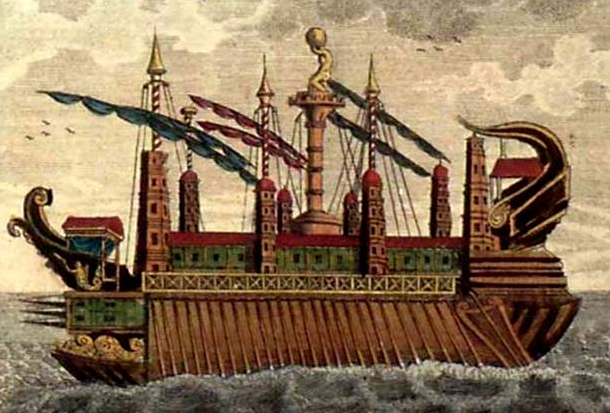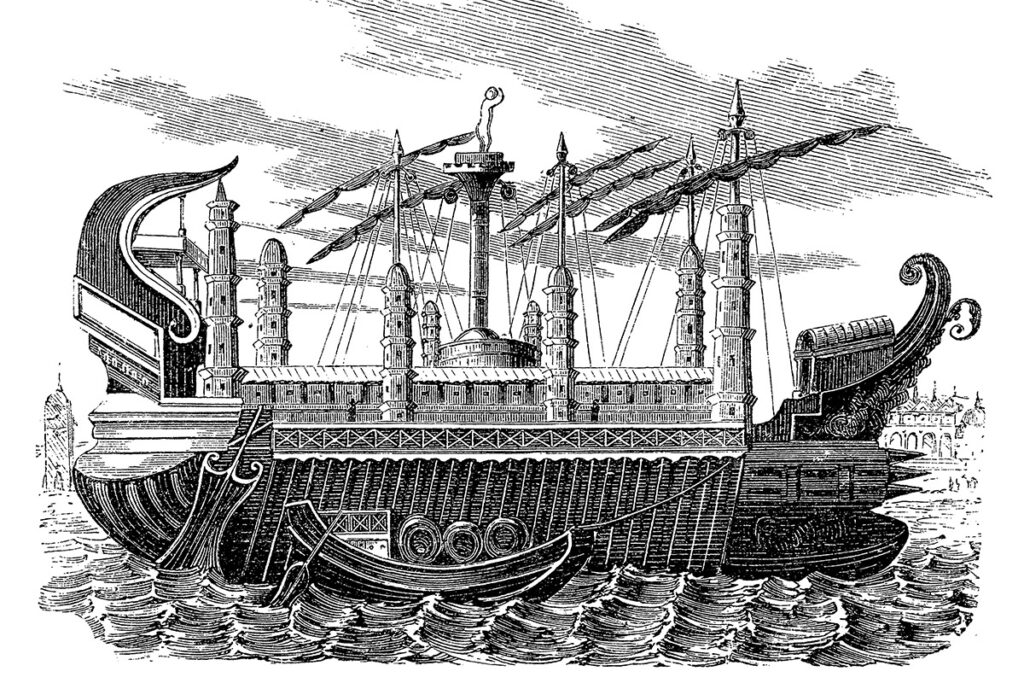Syracusia the colossus of the sea. Syracusia was probably one of the greatest mean of transport of the ancient world.
It was built in 240 BC and it was a truly eighthwonder of the antiquity, an amazing project.
Here we are, close to the port of Kroton, the great and powerful city of Magna Graecia which gave support to Hannibal during the II Punic war.
The project of the creation of Syracusia was made by a man who was both witness and victim of the II Punic war.
His name is Archimedes of Syracuse, a very talented mathematician and inventor who made it very hard for Rome to conquer the great Greek power Syracuse, the Sicilian city.
Archimedes built this ancient ship over 100 meters long, equipped with gyms, garden cabins and temples like the one that can be seen in this 3D reconstruction.
Syracusia was indeed a floating giant and of course such a large and luxurious ship had to travel safely. In fact, Archimedes left nothing to chance.
The ship was equipped with two catapults and a large ballista always set ready to defend the passengers in case of pirate or enemy attack.
Archimedes designed the ship and the building was entrusted to Archia di Corinto by order of Gerone of Syracuse.
The ship could accommodate up to 500 people including soldiers and civilians and it was equipped with cabins of all sizes, just like today's cruise ships.
To strengthen the defences of the ship it was also equipped with eight turrets and the temple was dedicated to Aphrodite.
The three imposing main masts guaranteed the mighty ship a certain manoeuvrability despite its size and it was endowed with a full-bodied number of attached units employed to row in the lower part of the nava through a classic trireme system.
On both sides the ship was lined with lead to prevent ramming with other ships.
Inside there was a library too. Subsequently, Syracusia was given to King Ptolemy III of Egypt so it was renamed Alexandria
From History Defined by Shayla Cherry
Syracusia was an ancient ship that sailed out of Syracuse.
At that time, it was an independent colony located on the island of Sicily. Hiero II of Syracuse commissioned it in the third century BC and sent it to Ptolemy III Euergetes in Alexandria.
This ancient Greek ship was so massive that no Sicilian port could accommodate it.
It sailed once, from Syracuse to Egypt, and then disappeared from the historical record.

A depiction of the Syracusia by Robert von Spalart, 1810
The Size of Syracusia
Syracusia was at least 180 feet long, 40 feet wide, and 40 feet tall.
Other sources indicate that the ship might have been as much as 360 feet long.
This was gargantuan at the time, more than ten times larger than most ships of the era.
This was gargantuan at the time, more than ten times larger than most ships of the era.
At the time of its construction, it was the largest ship ever built.
It took three hundred workers a full year to build Syracusia.
It took three hundred workers a full year to build Syracusia.
The timber used in its construction could have built 60 standard trireme ships, the galleys used by ancient Greeks and Romans.
Historians estimate that Syracusia could carry nearly two thousand passengers.
Historians estimate that Syracusia could carry nearly two thousand passengers.
Very nearly as many as the ill-fated Titanic.
In addition to these passengers, the ship could have carried over 1800 tons of cargo – ten times the amount of the average cargo ship at that time.
In addition to these passengers, the ship could have carried over 1800 tons of cargo – ten times the amount of the average cargo ship at that time.
There were also twenty stalls for horses.
On its single voyage, Syracusia carried two hundred soldiers and a catapult.
On its single voyage, Syracusia carried two hundred soldiers and a catapult.
The cargo included ten thousand jars of pickled fish, huge quantities of grain, and piles of wool.
There was also a massive container full of fresh water.
The cistern was able to hold an estimated 76 tons of water.
There was also a cistern full of seawater and fish to ensure easy access for the ship’s cook.
Ancient texts describe a huge top deck supported by intricately carved wooden columns in the shape of the Greek Titan Atlas, who held up the sky.
Ancient texts describe a huge top deck supported by intricately carved wooden columns in the shape of the Greek Titan Atlas, who held up the sky.
There were 142 first-class cabins aboard the Syracusia and additional space for 400 soldiers below.
It boasted eight towers, each of which was designed to hold two archers and four armed men. In addition to masts and sails, the ship had twenty rows of oars.
It boasted eight towers, each of which was designed to hold two archers and four armed men. In addition to masts and sails, the ship had twenty rows of oars.
The upper deck was protected from attack by a palisade.
This opulent luxury vessel held recreational spaces such as a gymnasium, a library, extensive kitchens, a grand dining room, and an indoor bathroom equipped with hot water.
This opulent luxury vessel held recreational spaces such as a gymnasium, a library, extensive kitchens, a grand dining room, and an indoor bathroom equipped with hot water.
It was decorated with luxury materials like marble and ivory floors that depicted scenes from the Iliad.
Special casks of soil held living plants, including vines and flowers.
Special casks of soil held living plants, including vines and flowers.
In the end, Syracusia was so enormous that no port in Sicily could accommodate her.
The only known port that could host the enormous ship was in Alexandria, and so Hiero II decided to send the ship to the pharaoh of Egypt as an extravagant gift.

In his youth, he served as a general under the Greek king Pyrrhus of Epirus.
He became king of Syracuse after marrying the daughter of its leading citizen and successfully defending the island against a group of Campagnian mercenaries. His wife, Queen Philistis of Syracuse, featured on the island’s coins.
Following the First Punic War, Hiero II entered into a treaty with Rome that allowed him to continue to rule over southeastern Sicily.
He became king of Syracuse after marrying the daughter of its leading citizen and successfully defending the island against a group of Campagnian mercenaries. His wife, Queen Philistis of Syracuse, featured on the island’s coins.
Following the First Punic War, Hiero II entered into a treaty with Rome that allowed him to continue to rule over southeastern Sicily.
This alliance continued until his death in 215 BC.
Syracusia was commissioned by Hiero II and designed by the Greek mathematician Archimedes around 240 BC.
Syracusia was commissioned by Hiero II and designed by the Greek mathematician Archimedes around 240 BC.
He also devised a way to move the ship using a complex system of pulleys.
Archimedes was born in Syracuse in 286 BC.
Ten years prior to the construction of Syracusia, Archimedes wrote On Floating Bodieswhich described several principles of hydrostatics.

Archimedes Thoughtful (also known as Portrait of a Scholar) by Domenico Fetti, 1620.
He wrote letters to Hiero II and in one letter pronounced, “Give me a place to stand and I will move the Earth!” Archimedes’ mastery of complex pulley systems was unmatched, and this attracted the attention of the king.
Many theories and achievements have been attributed to this great mathematician, including the Archimedes Principle of buoyancy, the concept of the center of gravity, and an approximation of pi.
He was a mechanical engineer whose inventions include compound pulleys and the Archimedean screw.
He also invented stone-throwing war machines intended to protect Syracuse from the Romans.
He also invented stone-throwing war machines intended to protect Syracuse from the Romans.
But in the end, the Romans killed him anyway.
During the Second Punic War, after the death of Hiero II, Syracuse switched its alliance from Rome to Carthage and was attacked by Rome. Leaders urged the soldiers not to kill Archimedes, but he was murdered during the siege of Syracuse in 212 BC.
The island of Sicily was claimed by Rome.
During the Second Punic War, after the death of Hiero II, Syracuse switched its alliance from Rome to Carthage and was attacked by Rome. Leaders urged the soldiers not to kill Archimedes, but he was murdered during the siege of Syracuse in 212 BC.
The island of Sicily was claimed by Rome.
Ptolemy III Euergetes
Ptolemaios Euergetes (translation: Ptolemy the Benefactor) was the third pharaoh of the Ptolemaic dynasty, which ended two centuries later with Cleopatra.
This dynasty, which would become the longest-reigning dynasty in Egyptian history, was at its height during his lifetime.
Due to political infighting and his mother’s exile, Ptolemy Euergetes was raised on the Greek island of Thera.
Due to political infighting and his mother’s exile, Ptolemy Euergetes was raised on the Greek island of Thera.
He was tutored by Apollonius of Rhodes, who eventually became the head of the Library of Alexandria. Ptolemy III succeeded his father in 246 BC.
Ptolemy III married the queen of Cyrenaica (the eastern half of modern-day Libya) when he became pharaoh, thereby bringing her lands into the Ptolemaic Empire.
The Third Syrian War spanned the first five years of his reign, but he was forced to abandon this victorious campaign abroad due to uprisings back home.
Ptolemy III married the queen of Cyrenaica (the eastern half of modern-day Libya) when he became pharaoh, thereby bringing her lands into the Ptolemaic Empire.
The Third Syrian War spanned the first five years of his reign, but he was forced to abandon this victorious campaign abroad due to uprisings back home.
What became of Syracusia after its arrival in Egypt is unknown.
Ptolemy IV Philopator was a small child when the ship was given to his father.
Ptolemy IV Philopator was a small child when the ship was given to his father.
He tried to outdo it years later by commissioning a monstrous ship of his own.
Tessarakonteres was so enormous that it was almost immobile and completely useless.
Tessarakonteres was so enormous that it was almost immobile and completely useless.
It was said to have carried nearly seven thousand men.
If this is true, it was the largest ship to have existed in antiquity and the largest human-powered vessel ever constructed.
Links :
- HistoryofYesterday : Syracusia: The Biggest Naval Ship In Ancient History
No comments:
Post a Comment